
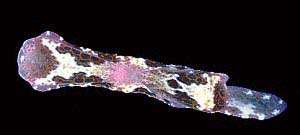
Odontoglaja guamensis
Rudman, 1978
Order: CEPHALASPIDEA
Family: Aglajidae
DISTRIBUTION
Originally described from Guam but now known from many sites in the tropical western Pacific Ocean.
PHOTO
Two colour forms from Koumac, northern New Caledonia, October 1993. Maximum length about 11mm. PHOTOS: Bill Rudman.
Until this interesting animal was discovered by Clay Carlson & Patty-Jo Hoff in Guam, all aglajids were characterised by the lack of radular teeth and gizzard plates. These predatory opisthobranchs, related to Philine, have reached a peak in predatory specialisation eating highly mobile prey animals including polychaete worms and other opisthobranch molluscs.
Odontoglaja guamensis has philinid-like radular teeth and a rudimentary gizzard, but in other anatomical features is clearly an aglajid. Although modern taxomonists shouldn't talk about "missing links" this species has an interesting mixture of ancestral and "modern" (derived) characters.
-
Rudman, W.B.,1978. A new species and genus of the Aglajidae and the evolution of the philinacean opisthobranch molluscs. Zoological Journal of the Linnean Society, 62: 89-107.
Rudman, W.B., 1998 (October 14) Odontoglaja guamensis Rudman, 1978. [In] Sea Slug Forum. Australian Museum, Sydney. Available from http://www.seaslugforum.net/find/odonguam
Related messages
Odontoglaga guamensis from Sri Lanka
October 5, 2007
From: Anouk Houben
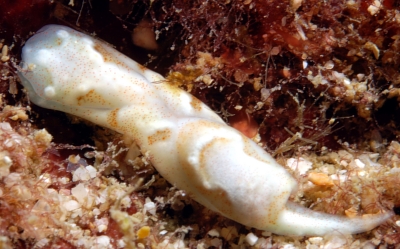
I found this tiny snail off the South-coast of Sri Lanka. I would place it in the order of headshield slugs under Aglajidae. Can you identify this one further?
Locality: Prinz Heinrich Patch, Weligama, 15 m, Sri Lanka, Indian Ocean, April 2007, rock formations. Length: 1.5cm. Photographer: Anouk Houben.
Kind Regards,
Anouk
nashiman@lankacom.net
Houben, A., 2007 (Oct 5) Odontoglaga guamensis from Sri Lanka. [Message in] Sea Slug Forum. Australian Museum, Sydney. Available from http://www.seaslugforum.net/find/20839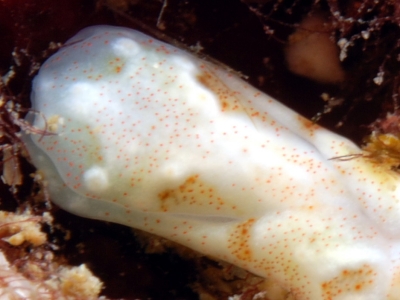
Dear Anouk,
Yes this is an aglajid. It is Odontoglaga guamensis, a small species which still has radula teeth, which have been lost in other aglajids. Your animal does not have the full colour pattern usually seen in this species, but the distribution of the small orange-brown spots is the same, so I would be very surprised if it was anything more than a pale specimen.
Best wishes,
Bill Rudman
Odontoglaja guamensis from South Africa
September 7, 2007
From: Valda Fraser
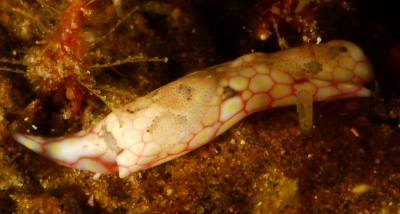
Dear Bill
Searched the species list, but .. no luck! Not able to find this Chelidonura. Please help. Awful image, but good enough for identification.
Locality: Sodwana, 15 m, South Africa, Indian, Jan 2007, Sandy area near reef. Length: 15 mm. Photographer: Valda Fraser.
Regards
Valda
valdafraser@mweb.co.za
Fraser, V.J., 2007 (Sep 7) Odontoglaja guamensis from South Africa. [Message in] Sea Slug Forum. Australian Museum, Sydney. Available from http://www.seaslugforum.net/find/20659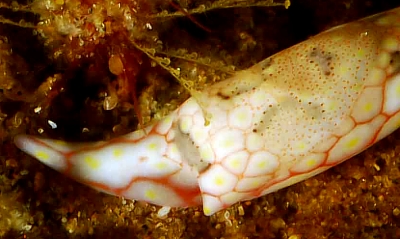
Dear Valda,
This is an interesting relative of Chelidonura called Odontoglaja guamensis. The name odontoglaja means the 'toothed aglaja' because it has radular teeth which are absent in other aglajids, and links the family to the philinids and gastropterids, which have similar radular teeth. At 15 mm, it is quite a large example. I have included a close-up of part of the animal as it shows the colour pattern rather well.
Best wishes,
Bill Rudman
Odontoglaja guamensis mating
August 17, 2005
From: Colin Ogden
Hi Bill,
Thanks for that fascinating response on the above [message #14502 ].
Your forum is much appreciated, and I am learning a great deal from the info. I am finding so many creatures here that I cant ID so your help is really needed,
Thanks a ton
Colin
scubacoa@iafrica.com
Ogden C M, 2005 (Aug 17) Odontoglaja guamensis mating. [Message in] Sea Slug Forum. Australian Museum, Sydney. Available from http://www.seaslugforum.net/find/14569Odontoglaja guamensis - unusual mating behaviour [2]
August 12, 2005
From: Colin Ogden
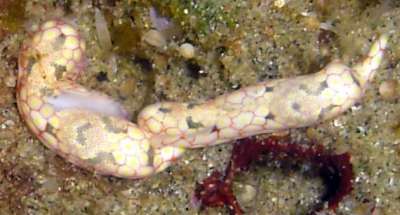
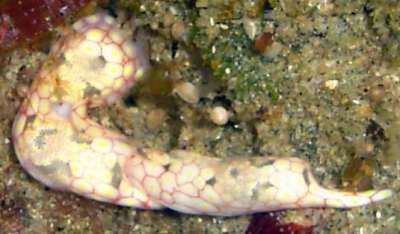
Hi Bill,
following my last message on the mating behaviour of these creatures [#14456 ], I came across these two and managed to spend a bit more time with them. Unfortunately I had to leave before the end (compulsory deco)
The first pic shows the approach of the one Odontoglaja guamensis, and the second pic shows the other allowing the approacher to actually totally penetrate its body. It opened its mantle to allow this to occur. Is this the way these creatures normally mate. I would of expected them to be the same as the nudibranchs.
Locality: Sodwana Bay, South Africa, Indian ocean coast. Depth: 22 metres. Length: 15 mm. August 4 2005. Coral reef. Photographer: Colin Ogden
Your comment would be appreciated.
Regards
Colin
scubaco@iafrica.com
Ogden C M, 2005 (Aug 12) Odontoglaja guamensis - unusual mating behaviour [2]. [Message in] Sea Slug Forum. Australian Museum, Sydney. Available from http://www.seaslugforum.net/find/14502Dear Colin,
The cephalaspideans [bubble shells] are more like the sea hares in general anatomical features - especially where 'openings' are concerned than nudibranchs. The penis is in a pouch on the right side of the head, quite separate from the female reproductive openings which are in the mantle cavity on the right side of the body, beneath the reduced shell near the rear of the body. As in the sea hares, the aglajids, and most other cephalaspideans, have a sperm groove which runs from the genital openings at the rear forward to the penis. This differs from the nudibranchs in which all the genital openings, including the penis sac, are found together on the right side of the body in the anterior quarter. This means that cephalaspideans and sea hares tend to mate head to tail rather than head to head. This can lead to them forming mating chains where three or more animals mate simultaneously, the ones in the middle being simultaneously male and female. There are photos of sea hares doing this on the mating chains Fact Sheet, and there is a nice photo of the aglajid, Chelidonura livida doing the same in Michael Mrutzek's earlier message [#8036 ]
The animal acting as 'male' is not actually penetrating the body of its partner. It is lying on top of the hidden shell and mantle cavity of the 'female' so that its penis, which is on the right side of the head, can enter the genital opening of its partner which is directly below where it is lying. In the case of Chelidonura livida the mantle cavity is even more reduced so the 'male' can access the genital openings of the 'female' from directly behind.
These groups represent early stages in the evolution of shelled snails to slugs. Have look at the Detorsion - how snails became sea slugs page for some background information.
Best wishes,
Bill Rudman
Odontoglaja guamensis - mating behaviour
August 2, 2005
From: Colin Ogden
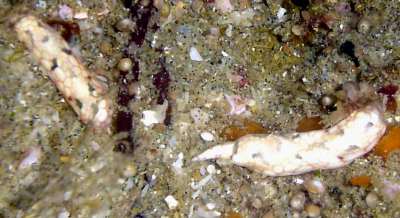
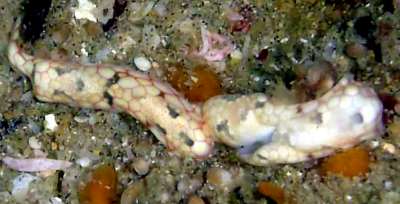
Hi Bill,
Recently I came across these 2 Odontoglaja guamensis. One was creeping up slowly on the other one. As the one neared the creature in the front, the leader started opening its mantle and exposing what I believe is its internal shell. I think this was in preparation for mating. The first photo shows the approach, and the second the opening of its mantle. Unfortunately at this stage I could not take any further photos as my divers I was leading had run low on air and I had to take them back to the surface.
Locality: Sodwana Bay, South Africa. Indian Ocean. Depth: 22 metres. Length: 15 mm. 24 July 2005. Coral reef. Photographer: Colin Ogden
Regards
Colin
scubaco@iafrica.com
Ogden C M, 2005 (Aug 2) Odontoglaja guamensis - mating behaviour. [Message in] Sea Slug Forum. Australian Museum, Sydney. Available from http://www.seaslugforum.net/find/14456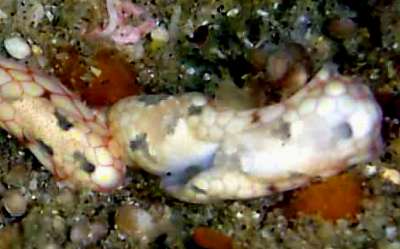
Dear Colin,
I'm sure you're right about the mating behaviour, but I am pretty sure the white you can see is not the shell but a colourless part of the mantle tissue, usually not exposed. The shell in aglajids is enclosed within the 'skin' of the mantle, unlike many other bubble shells where it is either wholly or partly visible.
Best wishes,
Bill Rudman
Re: Odontoglaja guamensis from South Africa
July 1, 2005
From: Colin Ogden
Hi Bill,
Thanks for your ID [#14101] on the Odontoglaja guamensis. Your comment on size is correct. It was only about 10 to 15mm. There seems to be a huge variation in the colour of this animal, as I have referred to the photo's in Debelius and also on the Forum, and it needs an expert to ID these.
Your help is really appreciated
Thanks
Colin
scubaco@iafrica.com
Ogden C M, 2005 (Jul 1) Re: Odontoglaja guamensis from South Africa. [Message in] Sea Slug Forum. Australian Museum, Sydney. Available from http://www.seaslugforum.net/find/14172Dear Colin,
Thanks for the size correction. Some species seem to be very variable in colour while others seem to have a very constant colour pattern. That's why I encourage photos of species which we seem to have plenty of examples on the Forum. It gives us an opportunity to see a species in its entirety. One warning I should give is there is always the possibility that I have got it wrong. In many cases, the only way to be really sure is to have a look at the anatomy.
As an example, I was once investigating some little bright yellow chromodorids in southeastern Australia which live on a bright yellow sponge. I thought there was only one species, but when I was preparing a description of what I thought was the one species I noticed that some specimens had gone dark brown, almost black, in preservative, while the rest had just lost their yellow colour and were translucent white. Luckily I decided to check the anatomy of both types and found that there were indeed two species. At the back of my mind I always have these two species, Noumea closei and N. suphurea, reminding me to never be too confident.
Best wishes,
Bill Rudman
Odontoglaja guamensis from the Red Sea
June 29, 2005
From: Binyamin Koretz
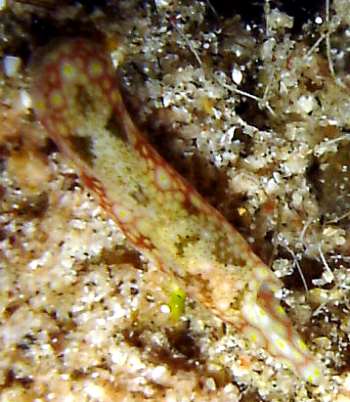
Hi Bill,
Here's another small aglajid slug we haven't seen before. Is it Odontoglaja guamensis?
Locality: Eilat, Lighthouse Beach, Israel. Red Sea (Gulf of Eilat). Depth: 16 m. Length: ca. 1 cm. 25 May 2005 (night). patch reef and rubble. Photographer: Binyamin and Shulamit Koretz
Thanks and regards
Binyamin
binyamin@koretz.net
Koretz, B., 2005 (Jun 29) Odontoglaja guamensis from the Red Sea. [Message in] Sea Slug Forum. Australian Museum, Sydney. Available from http://www.seaslugforum.net/find/13889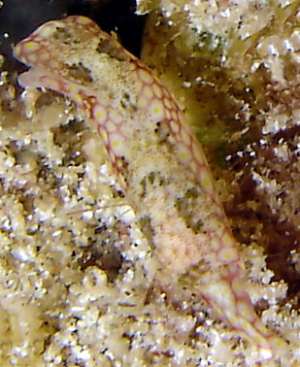
Dear Binyamin,
Yes this is Odontoglaja guamensis. It's nice to fill in some gaps in its known distribution.
Best wishes,
Bill Rudman
Odontoglaja guamensis from South Africa
June 29, 2005
From: Colin Ogden
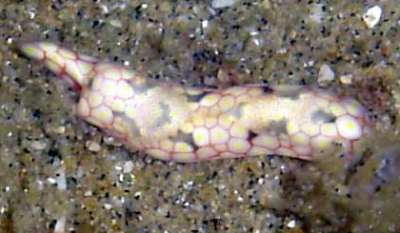
Hi Bill,
I cant find this nudi in any of my books. Is it a member of the chelidonura family. Thanks a ton
Locality: Sodwana Bay, South Africa. Indian Ocean coast. Depth: 22 metres. Length: 25 mm. June 2005. Coral reef. Photographer: Colin Ogden
Regards
Colin
scubaco@iafrica.com
Ogden C M, 2005 (Jun 29) Odontoglaja guamensis from South Africa. [Message in] Sea Slug Forum. Australian Museum, Sydney. Available from http://www.seaslugforum.net/find/14101Dear Colin,
Yes this is related to Chelidonura. I am pretty sure it is Odontoglaja guamensis, but your size of 25 mm seems rather large. From my experience it seldom grows larger than 10 mm - which is not to say it does not grow larger but it would be nice if you could confirm that.
Best wishes,
Bill Rudman
